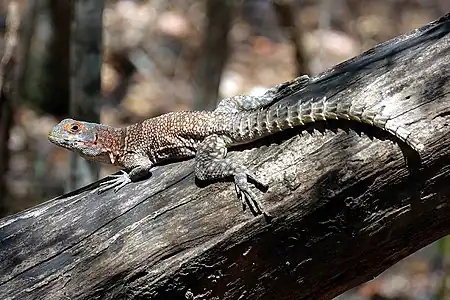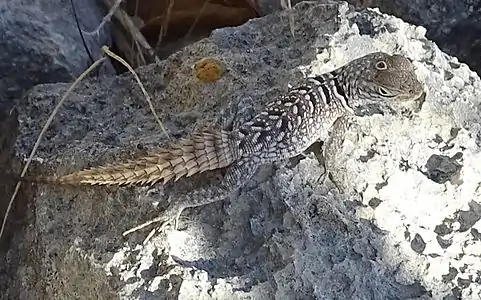| Oplurus cuvieri | |
|---|---|
 | |
| At Anjajavy Forest, Madagascar | |
| Scientific classification | |
| Domain: | Eukaryota |
| Kingdom: | Animalia |
| Phylum: | Chordata |
| Class: | Reptilia |
| Order: | Squamata |
| Suborder: | Iguania |
| Family: | Opluridae |
| Genus: | Oplurus |
| Species: | O. cuvieri |
| Binomial name | |
| Oplurus cuvieri (Gray, 1831) | |
| Synonyms[2] | |
| |
Oplurus cuvieri, commonly known as the collared iguana, the collared iguanid lizard, Cuvier's Madagascar skink, Cuvier's Madagascar swift, and the Madagascan collared iguana, is a species of arboreal lizard in the family Opluridae. The species is native to Madagascar and Comoros. There are two recognized subspecies. O. cuvieri is the largest of six species in the genus Oplurus.
Etymology
The specific name, cuvieri, is in honor of French naturalist Georges Cuvier.[3]
Description
As some of the common names suggest, O. cuvieri has a distinctive black collar that stands out against the body which is speckled with lighter spots. It has a large head, and the relatively short tail has spiny scales. The female is a duller brown colour.[4]
The average length of O. cuvieri is 16 in. and the average weight is 160 – 190 g.[5]
The images below show considerable variation in markings and coloration.

 At Tsimanampetsotsa National Park, showing a false eye on top of head
At Tsimanampetsotsa National Park, showing a false eye on top of head
Geographic range
The collared iguana is found in the western tropical forests of Madagascar and on the island of Grand Comore in Comoros.[1]
Subspecies
Two subspecies are recognized as being valid, including the nominotypical subspecies.[2]
- Oplurus cuvieri cuvieri (Gray, 1831) – Madagascar
- Oplurus cuvieri comorensis Angel, 1942 – Grand Comore Island
Nota bene: A trinomial authority in parentheses indicates that the subspecies was originally described in a genus other than Oplurus.
Diet
O. cuvieri has a mostly carnivorous diet.[4]
Behavior
This diurnal iguana species is primarily arboreal and spends much of its time gripping trunks and branches where
it remains motionless while it scans the surrounding area for insects.
Once It sees the prey, the lizard will run rapidly to capture it before it can
escape. Madagascar Collared Lizards have also been observed positioning
themselves near an ant trail where they can gain an easy meal by picking
up the ants one by one. Occasionally, they may also eat plant matter such
as flowers.
This lizard is territorial, found alone or in an area with one male and a few
females.
When threatened, it will retreat into a crack or crevice in a tree trunk, and
use its armored tail to form a barrier between itself and the predator. [5]
Reproduction
The sexual maturity of the Madagascar Collared Lizard is estimated at 2-3 years.
The breeding season for the Madagascar Collared Lizard is timed to
match the rainy season, with egg laying occurring just after the first heavy
rain. Males fight with one another for the females’ attention, often leading
to injury or even death. The female digs a hole about four inches deep
in open ground where there is no live vegetation, often on a man-made
forest trail. She lays her clutch, typically of 2-5 eggs, fills the hole with sandy soil and covers
it with sand, dead leaves and twigs so that the laying site blends into the
surroundings. The female then immediately leaves the nest site and neither
parent provides any degree of care for the hatchlings. Females may lay
several clutches per year.
Incubation of Madagascar Collared Lizard eggs lasts 61-71 days.[5]
Conservation
There is no data on the number of individuals in the wild and no known
conservation measures in place for this species. Its habitat in the forests
of Madagascar, however, faces a number of threats which may impact this
iguana; this includes the burning of forests for agricultural expansion and
the exploitation of trees for timber and charcoal.
In addition, because of their shallow, unprotected nesting sites, the eggs
are heavily preyed upon by other reptiles, most notably the Malagasy giant
References
- 1 2 Vences, M.; Hawlitschek, O. (2011). "Oplurus cuvieri ". IUCN Red List of Threatened Species. 2011: e.T172763A6913310. doi:10.2305/IUCN.UK.2011-2.RLTS.T172763A6913310.en. Retrieved 20 November 2021.
- 1 2 Oplurus cuvieri at the Reptarium.cz Reptile Database. Accessed 3 October 2020.
- ↑ Beolens, Bo; Watkins, Michael; Grayson, Michael (2011). The Eponym Dictionary of Reptiles. Baltimore: Johns Hopkins University Press. xiii + 296 pp. ISBN 978-1-4214-0135-5. (Oplurus cuvieri, p. 63).
- 1 2 "Collared iguana". Arkive. Archived from the original on 2014-05-30. Retrieved 5 September 2014.
- 1 2 3 4 "Madagascar Collared Lizard" (PDF). saczoo.org. December 2016. Archived from the original (PDF) on October 17, 2023. Retrieved October 17, 2023.
Further reading
- Boulenger GA (1885). Catalogue of the Lizards in the British Museum (Natural History). Second Edition. Volume II. Iguanidæ ... London: Trustees of the British Museum (Natural History). (Taylor and Francis, printers). xiii + 497 pp. + Plates I-XXIV. (Hoplurus sebæ, p. 129-130).
- Gray JE (1831). "A Synopsis of the Species of the Class Reptilia". In: Griffith E (1831). The Animal Kingdom Arranged in Conformity with its Organization, by the Baron Cuvier, with Additional Descriptions of All the Species hitherto Named, and of Many not before Noticed. Volume the Ninth. London: Whittaker, Treacher, and Co. 448 pp. + 110 pp. (Tropidurus cuvieri, p. 41 of 110 pp. supplement).
- Savage JM (1952). "The Correct Names for the Iguanid Lizards of Madagascar and the Fiji Islands". Copeia 1952 (3): 182. (Oplurus cuvieri, new combination).
